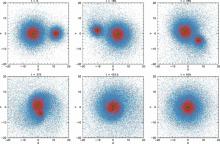
Abstract
We simulate mergers between galaxies containing collisionally-relaxed nuclei around massive black holes (BHs). Our galaxies contain four mass groups, representative of old stellar populations; a primary goal is to understand the distribution of stellar-mass BHs after the merger. Mergers are followed using direct-summation N-body simulations, assuming a mass ratio of 1:3 and two different orbits. Evolution of the massive BH binary is followed until its separation has shrunk by a factor of 20 below the hard-binary separation. During the galaxy merger, large cores are carved out in the stellar distribution, with radii several times the influence radius of the massive BH. Much of the pre-existing mass segregation is erased during this phase. We follow the evolution of the merged galaxies for approximately three, central relaxation times after coalescence of the massive binary; both standard, and top-heavy, mass functions are considered. The cores that were formed in the stellar distribution persist, and the distribution of the stellar-mass black holes evolves against this essentially fixed background. Even after three central relaxation times, these models look very different from the relaxed, multi-mass models that are often assumed to describe the distribution of stars and stellar remnants near a massive BH; in particular, the density of stellar BHs is much smaller than in those models. We discuss the implications of our results for the EMRI problem and for the existence of Bahcall-Wolf cusps.